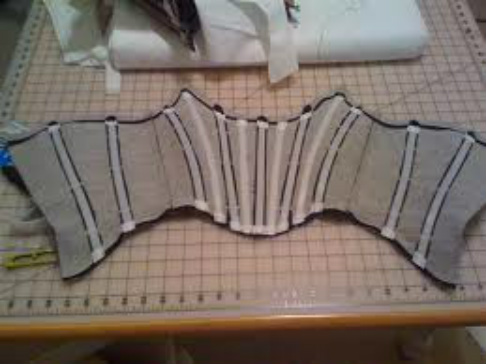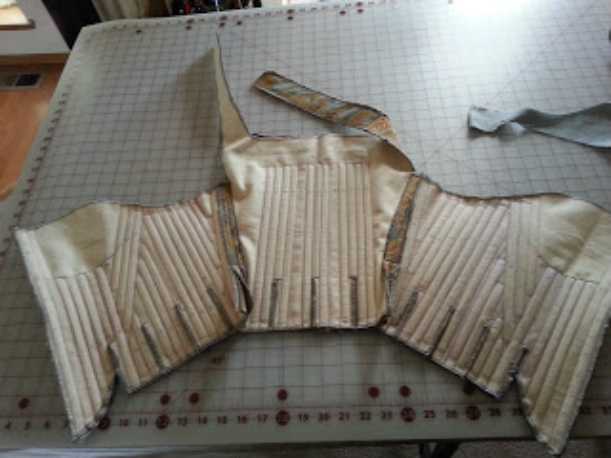
Incorporating Boning into A Corset Bodice. I dont see why a thick plastic cut into a boning shape wouldnt work I used pieces of a wire hanger tape the ends really really well if you do this it will sneak out of your corset and at best poke you in the tummy I got skritched up cardboard seems like it might even work depending on how its cut and how hardy you need the garment to be.

However the presence of the busk or front opening makes the corset far easier to put on and take off as the laces do not have to be removed or loosened as much.
Where to put boning in a corset. Sewn in at the side bust boning helps keep bust fullness from migrating into the armpit. Finish the boning ends by wrapping them with a firmly woven cotton fabric as you sew them. Stitch to the seam allowance.
Rigilene or precovered boning works for this method. Dont cut the boning at the bottom of the casing. You still need to sew the bottom of the casing and possibly sew a skirt onto the bottom of the bodice So cut the boning about 38 to 12 shorter than the casing.
Do this for each casing you have. This type of corset boning is also sprung and is ingenious because it flexes in all directions and is therefore particularly good for the more curvy areas of the body where you need a bit of moulding - over the breast over the hips perhaps over a fuller dierriere. Incorporating Boning into A Corset Bodice.
I started off by pinning all my pattern pieces down along the straight grain onto calico x4 satin x2 and polyester lining x2. I then cut them out and layered one set of calico panels onto the. The boning would be running up the front and sides of the bodice along with princess seams etc.
The seams with boning on them would continue up to the neckline where they dead-end into an embroidered collar. If a corset has a closed front boning is often put in the front panel especially if the front panel is pointed. This is just to stop the points from folding over.
How many bones should a corset have. As said above the boning is only there to support the seams and edges. You want to use steel not pictured and spiral bones right.
Steel bones can be used in the side or back seams where there is no curve. Spiral bones are used for the curved seams as they will contour to fit the seams of a corset where a straight bone would buckle. The best boning is made of steel.
Either spiral steel which is flexible and intended for curved seams or spring steel which is meant only for straight seams. The problem is corset supplies are neither cheap nor easy to acquire unless you happen to live in one of the few cities that can boast a corset supply shop like Farthingales. And then I stuck all 46 pieces in their boning channels.
There was still a lot of curve in some of the pieces so I alternated the direction of the curve like this. So that they balanced each other out and the corset was flatter. I still have to finish the top edge add grommets and put in the busk which is coming in the mail.
The boning is enclosed inside channels that is sewn inside interlining a layer of fabric inside outer fabric and lining and the boning pieces are slid into these slots. It is available in widths from 18 to 12 Purpose of boning. The boning is used to stiffen the fabric and stretch it out and even to make it stand upright.
Where to Put Boning in 18th Century Stays Corsets - YouTube. You have your 18th century stays pattern and youre ready to sew but maybe youd like to. The panels and boning on the corset are designed to lay at certain places on the body-so if your corset is way too small then the corset will not lay right on you.
Also bones will twist and warp and sometimes pop right through. I dont see why a thick plastic cut into a boning shape wouldnt work I used pieces of a wire hanger tape the ends really really well if you do this it will sneak out of your corset and at best poke you in the tummy I got skritched up cardboard seems like it might even work depending on how its cut and how hardy you need the garment to be. Boning - Types and Sewing Tips.
Boning helps a garment maintain its shape and stay wrinkle-free. While it is most often used in a corset bustier swimsuit or strapless gown it can also be used strategically in other garments. Use boning to stand up a collar keep folds or pleats in place and keep necklines from sagging.
Once upon a time corsets relied on whale boning for garment rigidity. This is perhaps how the interior structure of a corset came to be known generically as boning. The purpose of placing long thin bones or other materials within the structure of.
Now I can insert the steel bones into the boning channels I have already sewn and try the corset on to check that it fits. This one needs a bit of adjustment around the bust area - the front two seams need to be taken in by 1cm each at the top. The bust area is usually where the adjustments need to be made.
Introduction to corset boning - there are several different bones you can use to make a corset040 What is Boning Whats the purpose of boning115 Do bones. Does it work better for your pattern to have bigger bones or smaller ones. Most commercial corsets will use one ½ bone on each seam or two ¼ bones one on each side of the seam.
The main thing with metal boning is to make sure your boning fits. One trick I have learned on putting boning in strapless dresses which makes it easier to adjust the bust area later is to not put boning directly over the princess bust seam. Instead on the side front piece place a strip diagonally from the side waist up toward the top of the bust seam stopping just about an inch from the seam and neck edge.
If you are interested in hiding the steel boning you can make a cover layer and place it onto the body of the stays after securing the boning. If you want to use flossing I would research Renaissance embroidery and adapt those designs to hold the boning in place. Flossing just needs to secure the end of the boning.
The purpose of boning in a corset varies era to era. The corset and shaping put strain on the fabric so the boning was put in to give the desired shape and to prevent wrinkles in the fabric. In the 17th and 18th century corsets were heavily boned with little or.
All of our historic corsets feature a 5 or 6 loop steel busk making construction considerably harder. However the presence of the busk or front opening makes the corset far easier to put on and take off as the laces do not have to be removed or loosened as much. Busks appeared in the middle of the nineteenth century.